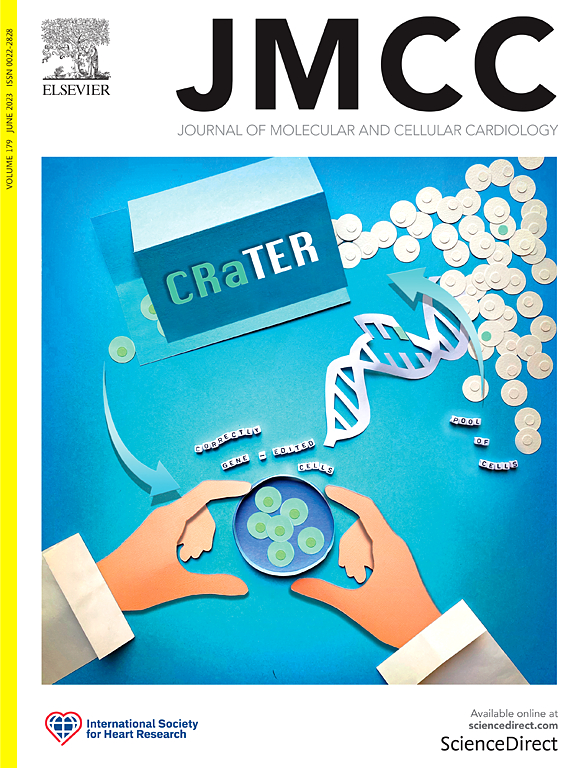靶向内皮细胞SMAD4改善高血压小鼠内皮功能障碍。
IF 4.7
2区 医学
Q1 CARDIAC & CARDIOVASCULAR SYSTEMS
引用次数: 0
摘要
目的:内皮功能障碍是高血压的关键因素,TGF-β/BMP信号通路的失调加剧了血管发病。然而,SMAD4在高血压血管炎症和功能障碍发展中的确切作用仍然知之甚少。方法:采用Tie2-Cre/ERT2系统生成内皮特异性Smad4敲除小鼠。血管紧张素II (Ang II)通过皮下植入渗透泵诱导高血压。使用钢丝肌图系统评估各种血管的内皮依赖性松弛(EDRs)。通过RNA-seq、qPCR、免疫荧光染色和western blotting检测基因在体内和体外的表达情况。在共聚焦显微镜下用荧光探针检测一氧化氮(NO)和活性氧(ROS)的产生。结果:与对照组EC-Smad4 WT小鼠相比,EC-Smad4 KO小鼠显示Ang ii诱导的血压升高显著降低。EC-Smad4 KO小鼠主动脉、肠系膜和颈动脉的edr明显改善。在EC-Smad4 KO小鼠的主动脉内皮中,AngII诱导的过量ROS生成和VCAM1表达被抑制。SMAD4敲除也导致p38 MAPK的磷酸化降低,以响应Ang II,增加Ser1177位点磷酸化的eNOS (p-eNOS)。此外,Smad4下调导致tunicamy霉素诱导内质网(ER)应激的关键标志物GRP78、ATF6和PERK的mRNA和蛋白水平降低。结论:Smad4信号是高血压患者内皮功能障碍和血管炎症的重要调节因子。内皮特异性缺失Smad4可通过降低氧化应激、抑制内质网应激和减轻血管炎症来改善血管功能障碍。本文章由计算机程序翻译,如有差异,请以英文原文为准。

Targeting endothelial SMAD4 ameliorates endothelial dysfunction in hypertensive mice
Objective
Endothelial dysfunction is a key contributor to hypertension, and dysregulation of TGF-β/BMP signaling pathways exacerbates vascular pathogenesis. However, the precise role of SMAD4 in the development of vascular inflammation and dysfunction in hypertension remains poorly understood.
Methods
Tie2-Cre/ERT2 system was used to generate an endothelial-specific Smad4 knockout mouse. Hypertension was induced by infusion of angiotensin II (Ang II) via implanting an osmotic pump subcutaneously. Endothelium-dependent relaxations (EDRs) of various blood vessels were assessed using a wire myograph system. Gene expression in vivo and in vitro was evaluated through RNA-seq, qPCR, immunofluorescence staining, and western blotting. Nitric oxide (NO) and reactive oxygen species (ROS) production were measured using fluorescent probes under confocal microscopy.
Results
EC-Smad4 KO mice showed a significant reduction in Ang II-induced blood pressure elevation compared to control EC-Smad4 WT mice. EDRs in the aorta, mesenteric, and carotid arteries were markedly improved in EC-Smad4 KO mice. In the aortic endothelium, excess ROS generation and VCAM1 expression induced by Ang II were suppressed in EC-Smad4 KO mice. SMAD4 knockdown also led to diminished phosphorylation of p38 MAPK in response to Ang II, increased phosphorylated eNOS (p-eNOS) at Ser1177. Additionally, Smad4 downregulation resulted in reduced mRNA and protein levels of GRP78, ATF6, and PERK, key markers of tunicamycin-induced endoplasmic reticulum (ER) stress.
Conclusion
Smad4 signaling is a critical mediator of endothelial dysfunction and vascular inflammation in hypertension. Endothelial-specific deletion of Smad4 ameliorates vascular dysfunction by reducing oxidative stress, suppressing ER stress, and alleviating vascular inflammation.
求助全文
通过发布文献求助,成功后即可免费获取论文全文。
去求助
来源期刊
CiteScore
10.70
自引率
0.00%
发文量
171
审稿时长
42 days
期刊介绍:
The Journal of Molecular and Cellular Cardiology publishes work advancing knowledge of the mechanisms responsible for both normal and diseased cardiovascular function. To this end papers are published in all relevant areas. These include (but are not limited to): structural biology; genetics; proteomics; morphology; stem cells; molecular biology; metabolism; biophysics; bioengineering; computational modeling and systems analysis; electrophysiology; pharmacology and physiology. Papers are encouraged with both basic and translational approaches. The journal is directed not only to basic scientists but also to clinical cardiologists who wish to follow the rapidly advancing frontiers of basic knowledge of the heart and circulation.

 求助内容:
求助内容: 应助结果提醒方式:
应助结果提醒方式:


